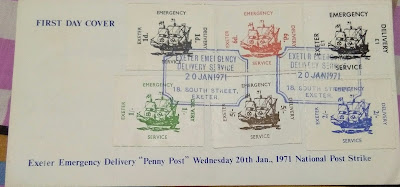1948 NEW ZEALAND " LANDING OF FIRST SETTLERS IN OTAGO " SHOWING IMAGE OF SHIP ON COVER
In 1948, the settlement of the Otago Province and the founding of the city of Dunedin on 23 March 1848 were commemorated by four stamps depicting the arrival of the immigrant ships, the town of Cromwell, the First Dunedin Church and the University of Otago. The stamps are classic James Berry designs, being full of fine detail. The 1d is famous for its colour shifts of the blue centre, examples of which can been seen below.
Otago celebrates the arrival of the immigrant ship John Wickliffe as the founding day of the province.
The ship and its 97 passengers sailed from Gravesend, England, on 24 November 1847. Three days later, the Philip Laing left Greenock, Scotland, with a further 247 people. Both ships were carrying Scottish settlers bound for New Zealand.
Plans for a New Zealand settlement for Scotland had begun in 1842. Scottish architect and politician George Rennie, concerned at English dominance over the first New Zealand Company settlements, hoped to establish ‘a new Edinburgh’ in the southern hemisphere. Dunedin – the Gaelic form of Edinburgh – became feasible once the New Zealand Company purchased the large Otago block from Ngāi Tahu in 1844.
Divisions within the Church of Scotland transformed Rennie’s original plan. Unhappy with patronage and state control, 400 clergy and about one-third of lay people quit the established church. Some of these dissenters, including Thomas Burns, William Cargill, and John McGlashan, saw Otago as a home for a new ‘Free Church’. Two-thirds of the original Otago settlers were Free Church Presbyterians.
In 1948, the settlement of the Otago Province and the founding of the city of Dunedin on 23 March 1848 were commemorated by four stamps depicting the arrival of the immigrant ships, the town of Cromwell, the First Dunedin Church and the University of Otago. The stamps are classic James Berry designs, being full of fine detail. The 1d is famous for its colour shifts of the blue centre, examples of which can been seen below.
Otago celebrates the arrival of the immigrant ship John Wickliffe as the founding day of the province.
The ship and its 97 passengers sailed from Gravesend, England, on 24 November 1847. Three days later, the Philip Laing left Greenock, Scotland, with a further 247 people. Both ships were carrying Scottish settlers bound for New Zealand.
Plans for a New Zealand settlement for Scotland had begun in 1842. Scottish architect and politician George Rennie, concerned at English dominance over the first New Zealand Company settlements, hoped to establish ‘a new Edinburgh’ in the southern hemisphere. Dunedin – the Gaelic form of Edinburgh – became feasible once the New Zealand Company purchased the large Otago block from Ngāi Tahu in 1844.
Divisions within the Church of Scotland transformed Rennie’s original plan. Unhappy with patronage and state control, 400 clergy and about one-third of lay people quit the established church. Some of these dissenters, including Thomas Burns, William Cargill, and John McGlashan, saw Otago as a home for a new ‘Free Church’. Two-thirds of the original Otago settlers were Free Church Presbyterians.






